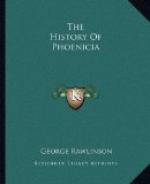We have now to return to the medallion which forms the centre of the cup. Within a circle of pearls or beads, similar to that separating the two zones, is a round space about two inches in diameter, divided into two compartments by a horizontal line. In the upper part are contained three human figures, and the figure of a dog. At the extreme left is a prisoner with a beard and long hair that falls upon his shoulders. His entire body is naked. Behind him his two arms are brought together, tied by a cord, and then firmly attached to a post. His knees are bent, but do not reach the ground, and his feet are placed with their soles uppermost against the post at its base. The attitude is one which implies extreme suffering.[784] In front of the prisoner, occupying the centre of the medallion, is the main figure of the upper compartment, a warrior, armed with a spear, who pursues the third figure, a fugitive, and seems to be thrusting his spear into the man’s back. Both have long hair, but are beardless; and wear the shenti for their sole garment. Between the legs of the main figure is a dog of the jackal kind, which has his teeth fixed in the heels of the fugitive, and arrests his flight. Below, in the second compartment, are two figures only, a man and a dog. The man is prostrate, and seems to be crawling along the ground, the dog stands partly on him, and appears to be biting his left heel. The interpretation which M. Clermont-Ganneau gives to this entire scene lacks the probability which attaches to his explanation of the outer scene. He suggests that the prisoner is the hunter of the other scene, plundered and bound by his charioteer, who is hastening away, when he is seized by his master’s dog and arrested in his flight. The dog gnaws off his right foot and then attacks the left, while the fugitive, in order to escape his tormentor, has to crawl along the ground. But M. Clermont-Ganneau himself distrusts his interpretation,[785] while he has convinced no other scholar of its soundness. Judicious critics will be content to wait the further researches which he promises, whereby additional light may perhaps be thrown on this obscure matter.
In its artistic character the “cup of Praeneste” claims a high place among the works of art probably or certainly assignable to the Phoenicians. The relief is high; the forms, especially the animal ones, are spirited and well-proportioned. The horses are especially good. As M. Clermont-Ganneau says, “their forms and their movements are indicated with a great deal of precision and truth."[786] They show also a fair amount of variety; they stand, they walk, they trot, they gallop at full speed, always truthfully and naturally. The stag, the hare, and the dog are likewise well portrayed; the ape has less merit; he is too human, too like a mere unkempt savage. The human forms are about upon a par with those of the Assyrians and Egyptians, which have evidently served for their models, the Assyrian for the outer zone, the Egyptian for the medallion. The encircling snake, as already observed, is a masterpiece. There is no better drawing in any of the other paterae. At best they equal, they certainly do not surpass, the Praenestine specimen.




